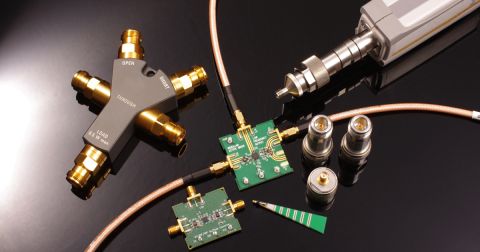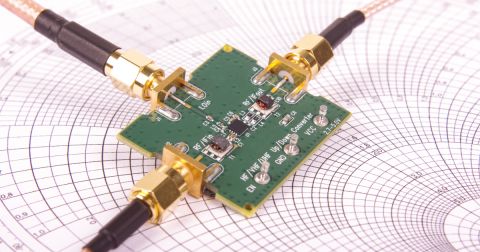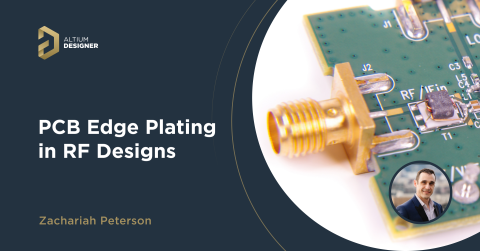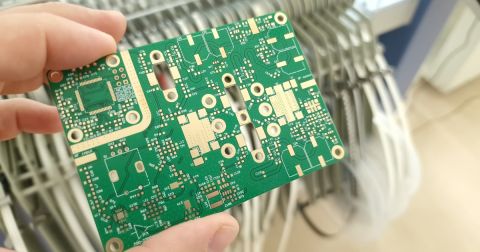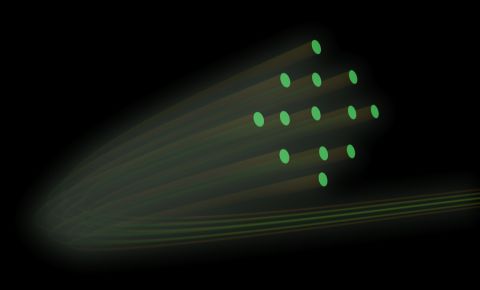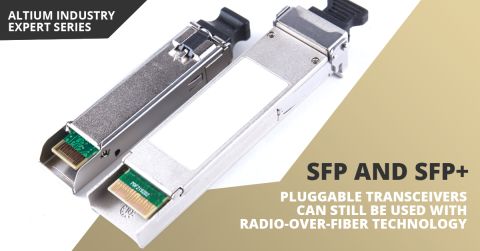Phased Array Antenna Design for 5G Applications

As the 5G rollout progresses and researchers continue to discuss 6G, many new 5G-capable products operating in sub-GHz and mmWave bands are reaching the marketplace. Devices that will include a 5G-compatible front-end, whether small stations/repeaters or handheld devices, use phased arrays as high-gain antenna systems to provide high data throughput without losing range at higher frequencies.
The earliest type of phased array antenna was constructed in 1905 by Ferdinand Braun. This simple antenna array consisted of three separate monopole antennas placed in an equilateral triangle with a base station in the center. The signal sent to one of the antennas was delayed by a quarter wavelength, which enforced directionality in the radiation pattern through interference. This same idea is used in arrays of patch antennas, where the delay between signals on a board is controlled with a phase shifter.
Now as many 5G-capable components are reaching the market, designers can incorporate antenna arrays into packages and onto PCBs. Two important requirements are tunability, where the response frequency of an antenna can be tuned or is compatible with a broad frequency range, as well as beamforming, where the radiation pattern from an antenna can be directed. The standard type of printed antenna used in packaging and PCBs for broadcasting at GHz frequencies for 5G networking is the microstrip phased array antenna. We'll outline how these antenna arrays are designed and placed in a PCB for use in 5G systems.
Phased Array Antennas in 5G
mmWave frequencies have always viewed as unsuitable for communication between mobile devices due to high losses. Scattering and absorption air attenuate signals to a greater degree than at lower frequencies, thus transmitters needed to operate at much higher power to compensate, making GHz wireless antennas impractical for long range communication in mobile devices. Despite the attenuation of mmWave frequencies, beamforming techniques can be used to focus radiation emitted from an array of antennas.
When implemented in a package or on a PCB, the phased array will most likely be a patch antenna array. When multiple patch arrays are arranged into a group, the resulting phased array antenna can be used for wireless and radar systems. This type of antenna consists of a number emitters that radiate in a spherical or dipole radiation pattern. Each antenna in the array must have particular spacing in order to provide the required interference that forms a beam with minimal side lobe generation.
There are two types of patch antennas used in phased arrays for 5G systems: series-fed patch arrays and parallel patch arrays. A single array of patches of each type is shown below, and a comparison of these arrays is provided in the following table.
|
|
|
|
|
|
|
|
|
|
|
|
|
|
|
|
|
|
|
|
When forming a patch array for mmWave systems, each group of patches shown above functions essentially as a single antenna element. Multiples of these antenna array elements are arranged together on a PCB to give the entire phased array. Overwhelmingly, PCBs or packages with phased arrays for 5G systems will use parallel patch antenna arrays for reasons discussed below.
These antennas can operate in a number of bands that include the LTE bands, as well as higher frequency bands that exceed 5 GHz. The higher frequency bands include 24.25-27 GHz and 37-40 GHz with 50 to 400 MHz bandwidth in each channel. The U.S. FCC recently opened up higher bands extending to 64-71 GHz, and similar bands are in use in Europe, Japan, and China. Operating in these bands requires properly sizing the antenna to support these frequencies in a fundamental mode, as we'll discuss below.
Series-Fed Patch Arrays
If you've ever designed a PCB for a radar system, or if you've looked at radar reference designs, you will see that the series-fed patch array is the standard antenna element used in radar. The reason for this is that the return loss and gain can be made highly frequency dependent, but they can still provide broad bandwidths. Because these arrays are essentially alternating sections of thin/wide transmission line sections, their gain spectrum is frequency dependent due to required propagation matching along the length of the antenna.
A typical series-fed patch array is shown below.

Parallel Patch Arrays
A patch array in parallel is shown below. This type of array achieves high gain through delay matching along the feedlines to each antenna element. This means the inner elements may need some meandering or phase shifting section in the feedline to provide the required delay matching; this is based primarily on feedline lengths and is relatively insensitive to frequency. The goal is to ensure that the input signal coming to each element in the parallel array is kept in-phase in all elements.
There are two other important design points in parallel patch arrays:
- The central feed point in the parallel array is a power divider that must provide equal power to all patches in the parallel array
- There is an input via that accepts a signal from a transceiver on the back side of the board or an internal layer feedline; it must not create impedance mismatch at the operating frequency
Most likely, there will be some impedance transformer sections between each patch and its feedline to ensure maximum power transfer and radiation efficiency from the array. An example of a simple parallel microstrip patch antenna arrays is shown below.

A variation on this is a parallel group of series arrays. This gives the frequency-dependecy benefits with sidelobe reduction, as well as high gain through superposition. However, there are multiple power divider sections with their own impedance transformer sections in the feedlines, and these must be carefully designed to ensure consistent phase shift across the array.

PCBs for 5G Phased Array Antennas
On a PCB, a phased-array antenna contains multiple radiating elements placed in a particular geometry. Each element is connected to a delay line or phase shifter, and interference among the radiation patterns from each antenna forms a beam with low divergence. The above patch array arrangements are formed into phased arrays by delaying the signal sent to each antenna by a set value. Because 5G-capable systems are requiring more antennas to provide higher gain/resolution, the antenna placement can take up a significant amount of real estate on the PCB.
An Array of Arrays
In 5G systems, there are two approaches to forming the complete phased array:
- From a combination of discrete patch antennas
- From a combination of parallel arrays
The number of discrete array elements (patches or parallel arrays) will determine total available gain of the array given its virtual array, as well as the maximum number of users that can be supported through beamforming/multiplexing.
The key to forming a phased array is to enforce phase matching. When a single transceiver is being used for all elements in the phased array, simply length-match the feedlines within an antenna group, as well as across all antenna groups, and the design will be assured to be in-phase. The example shows phase matching enforced using length tuning on feedlines leading to four series-fed patch arrays.

5G-capable smartphones can include anywhere from 6 to 10 individual patch array elements in order to ensure the device can transmit no matter how it is held during operation. Larger MIMO-capable transmitters in small cells could use multiple discrete patches or multiple parallel arrays. Each element in a 5G-capable phased array is normally placed with a feeder line routed through the back of the board. An example is shown below.
Patch antenna design for 5G applications as a phased array
In this example, the beamforming transceiver is controlling 8 discrete patch antennas. It could also be used to control multiple patch arrays. These beamformer modules are available as ICs that can be used to control the beam steering angle. A similar strategy is used for antenna-in-package designs. Just like the case of a phased array with series-fed patch antennas, the element spacing will determine the beamforming capabilities and viewing angle.
Many Antennas
As was mentioned above, there has been greater motivation to continue increasing antenna count as telecoms push towards mmWave deployments. More antennas equates to more gain and reduced sidelobe interference because the emitted beam exhibits greater resolution.
The situation is more difficult when we have a large number of transceivers that require phase matching across multiple antennas and/or multiple sub-arrays. In this case, a reference oscillator or reference clock must be distributed across all transceiver elements to enforce phase matching within some timing window. In this case, the reference clock must be routed on one layer, while the feedlines are operated on another layer. Length tuning is then needed across all traces in the reference oscillator distribution to ensure consistent timing. An example layer arrangement for a large array of patch arrays is shown below.

Design Strategy for Patch Antenna Arrays
The strategy for patch antenna arrays is typical for mmWave systems that implement MIMO functionality:
- Pick your operating band and understand your bandwidth
- Determine your antenna placement topology on your PCB or package based on the desired virtual array
- Size your antenna elements and determine matching sections at your operating frequency
- Check your S11 value at the patch array input point to verify bandwidth
- Arrange the patches in a larger array
The design strategy and the antenna topologies outlined above are standard for mmWave applications like radar and 5G, but they will likely continue scaling into 6G architectures operating well into mmWave frequency bands. Currently, the lower operating frequencies in the current 5G rollouts requires physically larger antennas to provide high broadcast power, and thus high gain with longer range. As new rollouts and eventually 6G push operating frequencies higher, the physical size of these antennas can be reduced.
Reduction in antenna size allows more antennas to be placed in a given area, which then increases the available gain and resolution of the output beam. Eventually, however, the phase matching conditions across antenna elements in an array becomes unscalable. Hybrid beamforming is considered one method to overcome the scalability challenges in very large arrays.
Alternative Types of Antennas and Arrays
An alternative type of array combines series and parallel patches into a unique array such as that shown below. The example below is topologically equivalent to parallel L-shaped networks operating at 10 GHz with 18.8 dBi gain and -11.9 dB sidelobe supression. A single 4x4 array as shown below can provide very wide field of view and could be scaled to a smaller radiator area at higher frequencies. The array has a feedline point through a via at the center of the structure, so it could be used to form sub-arrays with multiple transceivers in the standard configuration already being used in MU-MIMO systems with beamforming (spatial multiplexing). More information on this type of array can be found in the literature:

Another approach for use in smartphones and 5G-capable embedded devices is an antenna in-package approach. The example below shows a patch antenna-in-package concept where internal routing (striplines) is used with an aperture-coupled antenna. This type of antenna can operate well into the 100+ GHz regime with strong emission. In fact, we have used a similar structure for metallic waveguide coupling from a substrate integrated waveguide at WiFi frequencies.
Instead of a feedline and via being routed all the way up to a printed antenna on the surface layer, the feedline radiates to the emitting microstrip patch antenna on the top layer through an internal aperture. The image below shows one example operating at 122 GHz with an antenna-in-package design concept, although the same type of structure could be implemented in a PCB operating at much lower frequencies.

These innovative designs will be critical to increasing handset radiator efficiency and gain without increasing footprint, and they will be important in further improving the performance of 5G/6G systems. 6G systems will most likely start in the D-band above 100 GHz and will require these types of innovative antenna array designs, as well as alternative materials for heterogeneous ICs.
The CAD tools and mechanical collaboration features in Altium Designer® are essential for designing PCBs and packaging with 5G phased arrays and microstrip patch arrays suporting mmWave wireless systems. Altium Designer also provides an EDB model export extension for use in Ansys HFSS simulation programs. When you’ve finished your design, and you want to release files to your manufacturer, the Altium 365™ platform makes it easy to collaborate and share your projects.
We have only scratched the surface of what’s possible with Altium Designer on Altium 365. Start your free trial of Altium Designer + Altium 365 today.

